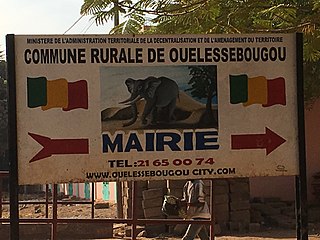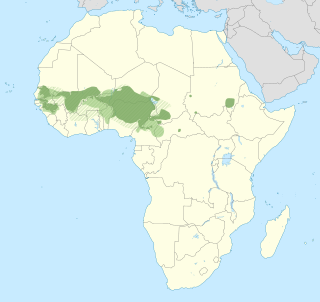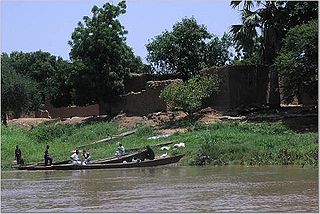Related Research Articles

Arabic is a Central Semitic language of the Afroasiatic language family spoken primarily in the Arab world. The ISO assigns language codes to 32 varieties of Arabic, including its standard form of Literary Arabic, known as Modern Standard Arabic, which is derived from Classical Arabic. This distinction exists primarily among Western linguists; Arabic speakers themselves generally do not distinguish between Modern Standard Arabic and Classical Arabic, but rather refer to both as al-ʿarabiyyatu l-fuṣḥā or simply al-fuṣḥā (اَلْفُصْحَىٰ).

Laal is an endangered language isolate spoken by 749 people in three villages in the Moyen-Chari prefecture of Chad on opposite banks of the Chari River, called Gori (lá), Damtar (ɓual), and Mailao. It represents an isolated survival of an earlier language group of Central Africa. It is unwritten except in transcription by linguists. According to former Summer Institute of Linguistics-Chad member David Faris, it is in danger of extinction, with most people under 25 shifting to the locally more widespread Bagirmi.
Bagirmi is the language of the Bagirmi people of Chad belonging to the Central Sudanic family, which has been tenatively classified as part of the Nilo-Saharan superfamily. It was spoken by 44,761 people in 1993, mainly in the Chari-Baguirmi Region, as well as in Mokofi sub-prefecture of Guéra Region. It was the language of the Sultanate of Bagirmi (1522-1871) and then the Wadai Empire before the Scramble for Africa.

Mali is a multilingual country of about 21.9 million people. The languages spoken there reflect ancient settlement patterns, migrations, and its long history. Ethnologue counts more than 80 languages. Of these, Bambara, Bobo, Bozo, Dogon, Fula, Arabic, Kassonke, Maninke, Minyanka, Senufo, Songhay languages, Soninke and Tamasheq are official languages. French is the working language.

The Sultanate or Kingdom of Bagirmi or Baghermi was an Islamic sultanate southeast of Lake Chad in central Africa. It was founded in either 1480 or 1522 and lasted until 1897, when it became a French protectorate. Its capital was Massenya, north of the Chari River and close to the border to modern Cameroon. The kings wore the title Mbang.

The Niellim language is a Bua language spoken by some 5,000 people along the Chari River in southern Chad. It is mainly spoken in two areas: one around the city of Sarh and one, its traditional home, further north, between about 9°30′ and 9°50′ N, corresponding to the former chiefdoms of Pra and Niou, as well as the Niellim Sultanate.

Fula, also known as Fulani or Fulah, is a Senegambian language spoken by around 36.8 million people as a set of various dialects in a continuum that stretches across some 18 countries in West and Central Africa. Along with other related languages such as Serer and Wolof, it belongs to the Atlantic geographic group within Niger–Congo, and more specifically to the Senegambian branch. Unlike most Niger-Congo languages, Fula does not have tones.

Pulaar is a Fula language spoken primarily as a first language by the Fula and Toucouleur peoples in the Senegal River valley area traditionally known as Futa Tooro and further south and east. Pulaar speakers, known as Haalpulaar'en live in Senegal, Mauritania, the Gambia, and western Mali. The two main speakers of Pulaar are the Toucouleur people and the Fulɓe. Pulaar is the second most spoken local language in Senegal, being a first language for around 22% of the population. This correlates with 23.7% of the country in which Pulaar is the population's ethnicity. Pulaar is one of the national languages of Senegal alongside 13 others. It was admitted as an official language of Senegal by Presidential decree in 1971. There are around 28 known dialects of Pulaar, most of which are mutually intelligible with each other. The Pulaar dialects, as well as other West African languages, are usually referenced under the umbrella term ‘Fula’. Pulaar as a language, however, is not usually referenced as ‘Fula’.

Chari-Baguirmi is one of the 23 regions of Chad. Its capital is Massenya. It is composed of part of the former Chari-Baguirmi Prefecture and parts of the sub-prefecture of N'Djamena).

Chadian Arabic, also known as Shuwa Arabic, Western Sudanic Arabic, or West Sudanic Arabic (WSA), is a variety of Arabic and the first language of 1.6 million people, both town dwellers and nomadic cattle herders. Most of its speakers live in central and southern Chad. Its range is an east-to-west oval in the Sahel. Nearly all of this territory is within Chad and Sudan. It is also spoken elsewhere in the vicinity of Lake Chad in the countries of Cameroon, Nigeria and Niger. Finally, it is spoken in slivers of the Central African Republic. In addition, this language serves as a lingua franca in much of the region. In most of its range, it is one of several local languages and often not among the major ones.
Zaghawa is a Nilo-Saharan language spoken by the Zaghawa people of east-central Chad and northwestern Sudan (Darfur). The people who speak this language call it Beria, from Beri, the endonym of the Zaghawa people, and a, Zaghawa for "mouth". It has been estimated that there are about 447,400 native speakers of the Zaghawa language, who primarily live in Chad and the Darfur region of Sudan. It is also spoken by a smaller number of people in Libya.
The Fula language is written primarily in the Latin script, but in some areas is still written in an older Arabic script called the Ajami script or in the recently invented Adlam script.
Yerwa Kanuri or Central Kanuri is a variety of the Kanuri language spoken mainly in adjacent parts of Nigeria, Niger, Cameroon, and Chad as well as by a diaspora community residing in Sudan. It is spoken by the Yerwa Kanuri who are the largest subgroup of Kanuri people in West and Central Africa today. Yerwa Kanuri is the largest of the Kanuri varieties, it is also used for both oral and written communication in Cameroon and is classified within the Saharan branch of the Nilo-Saharan language family. The Yerwa Kanuri variety of the Kanuri language in Nigeria is written using the Ajami script of the Arabic alphabet.
Adamawa Fulfulde is a variety of the Fula language. It is spoken mainly in Cameroon but also by significant communities residing in Nigeria, Chad, and Sudan by Fulani pastoralists across the Sahel. It is also known as Eastern Fulfulde and by various other names including Boulbe, Dzemay, Fula, Fulfulde, Mbororo, Palata, Peul etc.

Western Niger Fulfulde, also known as Gorgal Niiser Fulfulde is a variety of the Fula language, spoken mainly in Niger, and Burkina Faso, as well as by a small number of speakers in Benin by 3 million people. It has SOV word order and is closely related to other varieties of Fula spoken in Niger.
Maasina Fulfulde is a variety of the Fula language. It is spoken mainly in Mali, Ivory Coast, and Ghana by 1.6 million people. The language has several mutually intelligible dialects albeit with some differences. The variety is named after the Macina region in Mali.
Nigerian Fulfulde, also known as Hausa States Fulfulde, Fula, or Fulani is a variety of the Fula language spoken by the Fulani people in Nigeria, particularly in the Northern region of Nigeria. It belongs to the West Atlantic branch of the Niger-Congo language family. Phonologically, Nigerian Fulfulde exhibits a system of vowel harmony and a relatively simple consonant inventory, including stops, fricatives, and nasal sounds.
Borgu Fulfulde, also known as Borgu Fulani, Benin-Togo Fulfulde, Fulbe-Borgu, or Peul is a variety of the Fula language a West Atlantic language part of the Niger-Congo language family, it is spoken primarily in the Borgou Department of Benin, spanning Nigeria, other parts of Benin, as well as Togo and parts of Burkina Faso.
The Bagirmi or Barma are an ethnic group who inhabit the Chari-Baguirmi region of Chad. They are one of Chad's major ethnic groups.
Bagirmi Arabic, also known as Nigerian Arabic or Chad–Nigerian Arabic, is a Chadian Arabic dialect spoken by about 500,000 speakers on the Chad-Nigeria border, in the Borno State of Nigeria and the Baguirmi Department of Chad.
References
- 1 2 Bagirmi Fulfulde at Ethnologue (26th ed., 2023)

- 1 2 3 Gaden, Henry. 1908. Notes on the Foul dialect spoken by the Foulbé of Baguirmi. Asian Journal 11. 5-70.
- ↑ Harrison, Annette. 2003. Fulfulde language family report. SIL Electronic Survey Reports 2003-009. 1-13.
- 1 2 3 République du Tchad (2009). Décret fixant l’alphabet national du Tchad.
- 1 2 3 Priest, Lorna A.; Hosken, Martin (10 August 2010). "Proposal to add Arabic script characters for African and Asian languages" (PDF). The Unicode Consortium. Archived (PDF) from the original on 8 October 2022. Retrieved 5 May 2023.